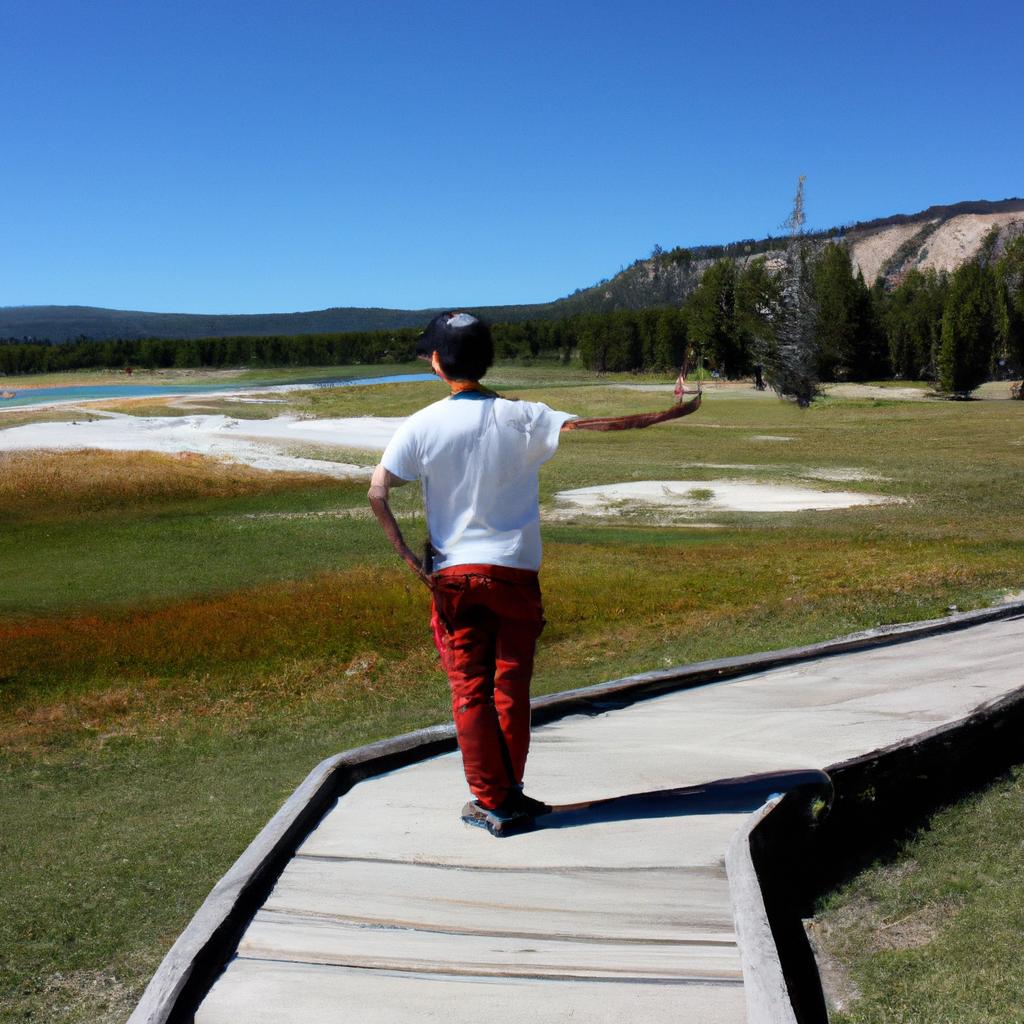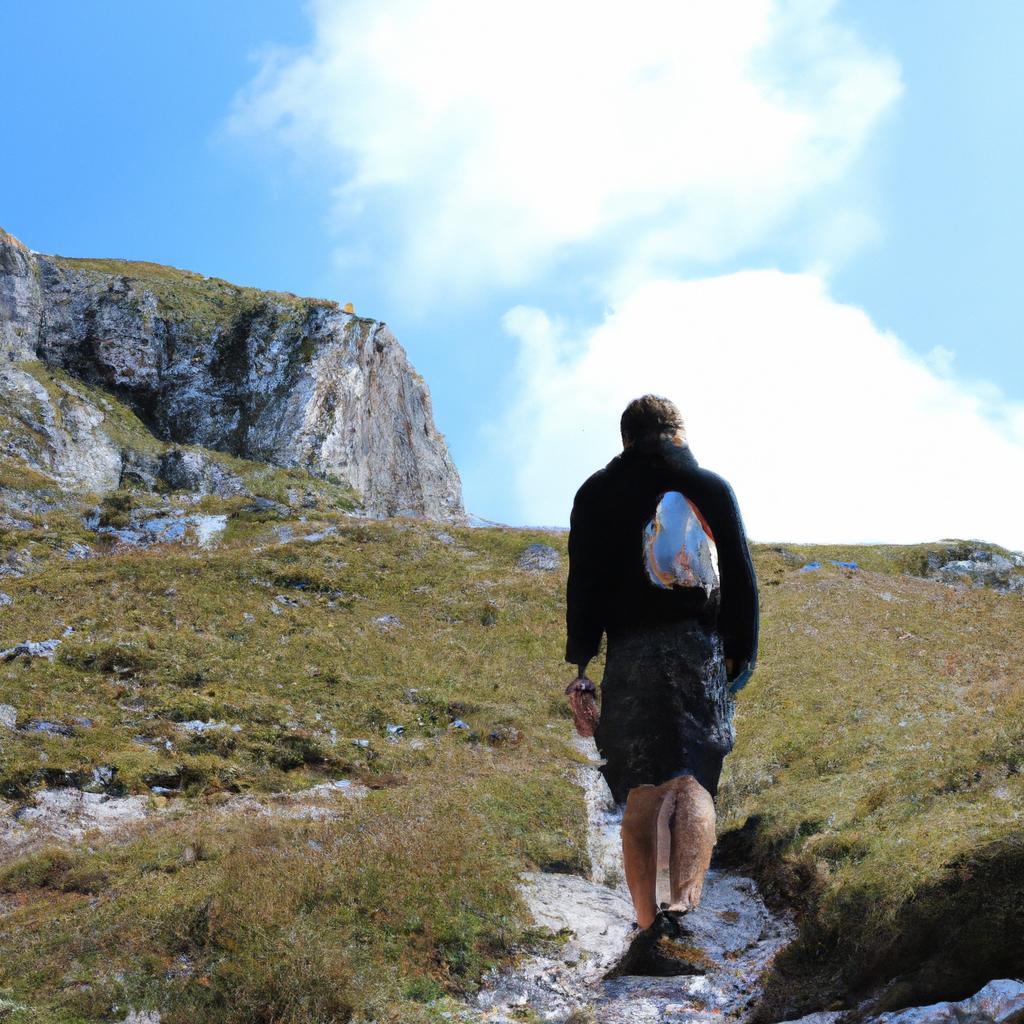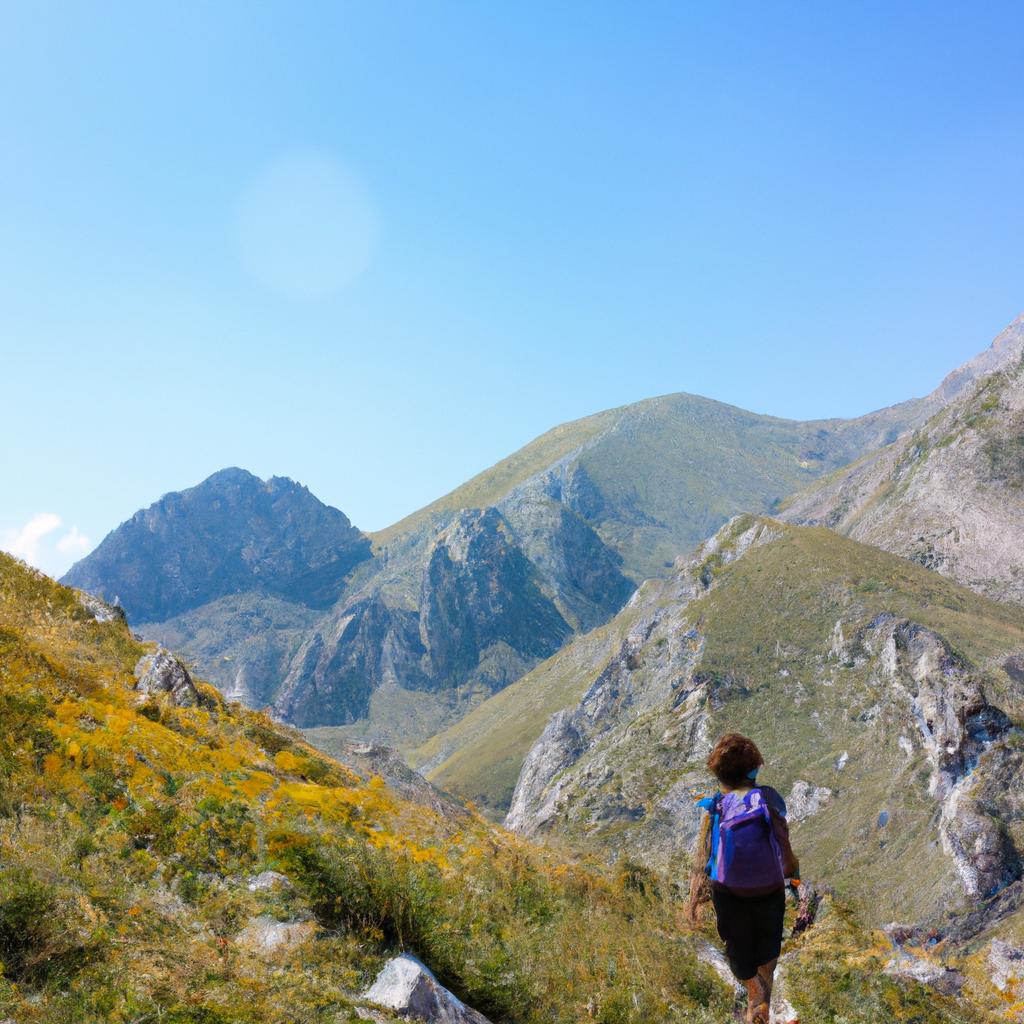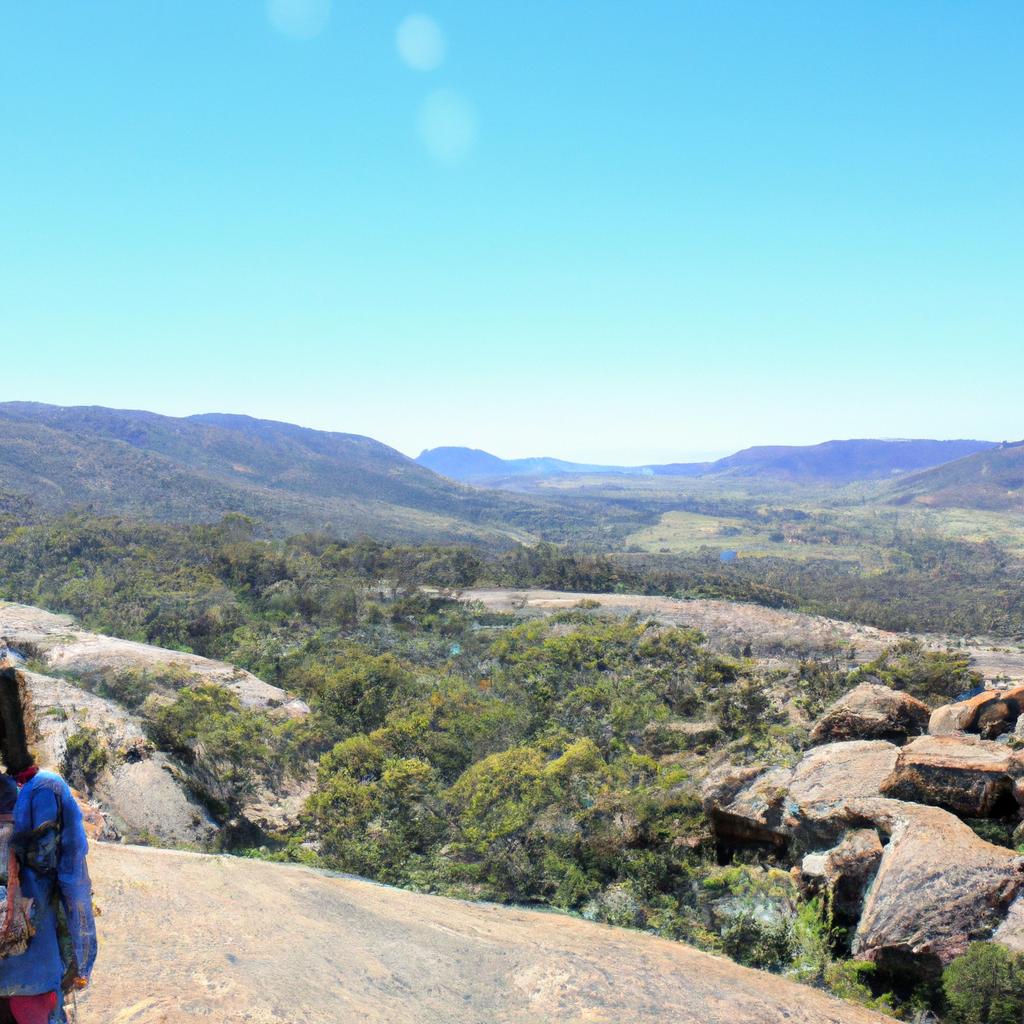The Grand Canyon, an awe-inspiring natural wonder located in the United States, has captivated visitors for centuries. Its vastness and beauty make it a must-see destination for travelers from all over the world. This article aims to explore the grandeur of North America’s majestic national park by delving into its geological history, unique ecosystem, and cultural significance.
Consider this hypothetical scenario: Imagine yourself standing on the edge of a precipice, overlooking a breathtaking landscape that seems to stretch endlessly before you. The sun casts radiant hues across the towering red rock formations, creating a mesmerizing display of colors. Below lies the mighty Colorado River, carving its way through layer upon layer of ancient rocks over millions of years. This is just a glimpse into what awaits those who venture into the depths of the Grand Canyon National Park.
In order to fully appreciate and understand this remarkable site, one must first delve into its geological origins. Over 6 million years ago, tectonic forces pushed up layers of sedimentary rock, exposing them to erosion by wind and water. Today, these processes continue to shape and transform the ever-changing landscape of the canyon. As we explore further, we will also uncover how this extraordinary environment sustains a diverse range of plant and animal life.
The unique ecosystem of the Grand Canyon is home to a wide array of plants and animals, adapted to survive in its harsh and extreme conditions. From the desert scrublands at the rim to the lush riparian zones near the river, this park showcases remarkable biodiversity. You may encounter iconic species such as bighorn sheep, mule deer, and elusive mountain lions roaming freely in their natural habitat. The canyon also provides shelter for over 300 bird species, including majestic raptors like golden eagles and peregrine falcons.
As you explore the trails that wind through the canyon walls, you’ll witness a stunning variety of vegetation. Desert-loving cacti and succulents cling to rocky outcrops while hardy shrubs and grasses thrive in more sheltered areas. In springtime, vibrant wildflowers carpet the landscape with bursts of color. The delicate balance between these plant communities contributes to the overall ecological health of the park.
Beyond its geological and ecological wonders, the Grand Canyon holds immense cultural significance for Native American tribes who have inhabited this region for thousands of years. The canyon’s towering cliffs serve as a canvas for ancient rock art panels that tell stories of their ancestors’ connection to this sacred land. Traditional ceremonies and rituals continue to be held by these indigenous communities, honoring their deep ties to this awe-inspiring place.
For visitors seeking adventure, there are numerous activities available within the park. Hiking trails range from easy walks along the rim to challenging treks into the heart of the canyon. Rafting trips down the Colorado River offer a thrilling way to experience its power firsthand. And for those looking for a more leisurely experience, scenic drives along Desert View Road or Hermit Road provide breathtaking vistas at every turn.
In conclusion, visiting the Grand Canyon National Park is an opportunity to witness nature’s grandeur on an epic scale. Its geological history, diverse ecosystem, and cultural significance make it a destination of unparalleled beauty and wonder. Whether you choose to explore its depths or simply stand in awe at the rim, the Grand Canyon will leave an indelible mark on your soul.
The Formation of the Grand Canyon
Imagine a vast, rugged landscape carved by nature’s unstoppable force over millions of years. This is precisely what you will witness when exploring the Grand Canyon, one of North America’s most mesmerizing natural wonders. The formation of this majestic canyon is a captivating tale that spans geological epochs and showcases the power of erosion.
To comprehend the magnitude of the Grand Canyon’s formation, let us consider an example: the Colorado River. As it meanders through the plateau region in Arizona, its relentless flow carves deep into ancient rock layers, gradually eroding away millennia of sedimentary deposits. Over time, this persistent process has shaped steep walls and exposed fascinating cross-sections of Earth’s geological history.
Understanding how such a colossal feature came to be requires recognizing several key factors:
- Geologic uplift: Forces beneath the Earth’s surface pushed up large blocks of rocks, creating elevated plateaus.
- Downward cutting rivers: Waterways like the Colorado River began their downward journey on these elevated surfaces.
- Erosion rates: The rate at which water and wind wear down rock layers plays a crucial role in shaping landforms.
- Climate changes: Shifts in climate patterns influenced water availability and intensified erosion processes.
By examining these influential elements together, we gain insight into the gradual transformation that occurred over countless centuries to create this awe-inspiring spectacle. To further illustrate this point, consider Table 1 below:
| Factors | Role |
|---|---|
| Uplift | Creation of elevated plateaus |
| Rivers | Initiation of downward erosion |
| Erosion rates | Shaping landforms over time |
| Climate changes | Influencing erosion intensity |
Through analyzing these components and observing evidence throughout the canyon itself, geologists have pieced together a timeline showcasing millions of years’ worth of Earth-changing events. The remarkable result is a sprawling masterpiece that stretches across approximately 277 miles (446 kilometers) and exposes rock layers that date back billions of years.
As we delve into the subsequent section about “Geological Wonders of the Grand Canyon,” it is crucial to remember that this breathtaking landscape evolved through a complex interplay of geological processes. The formation of the Grand Canyon serves as a testament to Earth’s transformative power, captivating visitors with its sheer magnitude and revealing glimpses into our planet’s ancient past.
Geological Wonders of the Grand Canyon
From the towering cliffs to the meandering river, the Grand Canyon is a geological wonder that captivates visitors from around the world. In this section, we will delve deeper into some of the most awe-inspiring features of this majestic national park.
One remarkable example of nature’s artistic prowess in shaping the Grand Canyon can be seen in its intricate network of rock layers. These layers tell a story that spans millions of years and reveal valuable information about Earth’s history. For instance, imagine standing at Yavapai Point, gazing out at the vibrant colors painted across the canyon walls. The crimson hues represent iron oxide-rich sandstone formed during an ancient desert environment, while the pale limestone layers signify marine environments present during different periods. This dynamic interplay between various sedimentary rocks showcases how environmental conditions have changed over time.
To truly appreciate the magnificence of the Grand Canyon, let us explore four key aspects that make it one of North America’s most treasured natural wonders:
- Vastness: With its immense size stretching over 277 miles long and up to 18 miles wide, the Grand Canyon leaves visitors feeling humbled by its sheer scale.
- Depth: Plummeting down more than a mile beneath its rim, this colossal chasm unveils layer upon layer of geological history.
- Diversity: From rugged cliffs to gentle slopes, from narrow slot canyons to expansive plateaus, the Grand Canyon offers a diverse range of landscapes waiting to be explored.
- Timelessness: As you stand on its rim and gaze into its depths, it becomes evident that time has stood still within these ancient walls for countless millennia.
In addition to these breathtaking characteristics, there are numerous fascinating formations scattered throughout the canyon’s expanse. To highlight just a few examples:
| Formation | Description |
|---|---|
| Vishnu Basement | Composed primarily of dark metamorphic rock, this formation represents some of the oldest rocks in the canyon. |
| Kaibab Limestone | Formed from ancient marine sediments, this layer creates the distinctive white cliffs seen at the North Rim. |
| Coconino Sandstone | Known for its unique cross-bedding patterns, this sandstone exhibits traces of wind-blown desert dunes. |
| Toroweap Formation | This layer showcases colorful volcanic deposits and provides a glimpse into past volcanic activity within the region. |
As we conclude our exploration of these geological wonders, it is crucial to remember that the Grand Canyon’s story extends far beyond its striking physical features.
Transitioning seamlessly into an examination of “Wildlife and Flora in the Grand Canyon,” let us now turn our attention to another facet of this unparalleled natural realm – one teeming with vibrant life and remarkable biodiversity.
Wildlife and Flora in the Grand Canyon
Section H2: Wildlife and Flora in the Grand Canyon
Transition from previous section: As we explore the depths of the Grand Canyon, let us now shift our focus to the diverse wildlife and rich flora that thrive within this remarkable national park. From soaring eagles to elusive bobcats, and vibrant wildflowers to towering ponderosa pines, these natural wonders coexist harmoniously amidst the rugged landscapes.
Example: Imagine standing on a precipice overlooking the vastness of the Grand Canyon, when suddenly an American black bear emerges from behind a rock formation. This encounter exemplifies the incredible biodiversity found within the park.
The unique combination of ecosystems created by varying elevations and microclimates offers refuge for numerous species. Here are some fascinating aspects of wildlife and flora in the Grand Canyon:
- Abundance of Species: With over 90 mammal species, 250 bird species, 25 reptile species, and countless insects calling it home, the Grand Canyon is teeming with life.
- Endangered Species: The California condor population recovery program has led to successful breeding efforts within the canyon walls, making it one of their primary habitats.
- Floral Diversity: Over 1,500 plant species have been documented in this arid region. Despite harsh conditions, hardy cacti like prickly pear and barrel cactus flourish alongside delicate wildflowers such as purple lupine and yellow desert marigold.
- Adaptation Strategies: To survive extreme temperature fluctuations and scarce water resources, many plants have developed specialized adaptations such as deep root systems or waxy coatings on leaves.
Let us take a closer look at some notable inhabitants through this table:
| Animal | Habitat | Notable Features |
|---|---|---|
| Bighorn Sheep | Steep cliffs | Impressive curved horns |
| Peregrine Falcon | Cliffs and crags | Fastest bird in the world |
| Mountain Lion | Rugged canyons | Solitary and elusive predator |
| Kaibab Squirrel | Ponderosa pine forests | Distinctive reddish fur |
As we continue our exploration of the Grand Canyon, our appreciation deepens for the intricate balance between wildlife and flora. These remarkable adaptations allow diverse species to thrive within this awe-inspiring natural sanctuary.
Transition to subsequent section – Hiking Trails and Outdoor Activities: Delving into the wonders of the Grand Canyon has undoubtedly sparked a desire for further discovery. Now, let us turn our attention toward the countless outdoor activities that await those who seek adventure amidst these breathtaking landscapes.
Hiking Trails and Outdoor Activities
As we delve deeper into the wonders of the Grand Canyon, let us now turn our attention to the various hiking trails and outdoor activities that await adventurous visitors. One such example is the popular Bright Angel Trail. With its breathtaking views and challenging terrain, this trail offers an unforgettable experience for nature enthusiasts.
-
Here are some key features of hiking in the Grand Canyon:
- Unparalleled Scenic Beauty: Immerse yourself in awe-inspiring vistas as you traverse through towering cliffs and deep canyons.
- Diverse Terrain: Encountering a variety of landscapes, from steep switchbacks to serene meadows, presents thrilling challenges at every turn.
- Rich Cultural History: Explore ancient Native American ruins along certain trails, providing glimpses into the area’s storied past.
- Abundant Wildlife Sightings: Keep your eyes peeled for sightings of bighorn sheep, elk, mule deer, and other fascinating wildlife species.
To further illustrate the allure of these experiences, consider the following table showcasing the diverse range of hiking trails available in different parts of the park:
| Trail Name | Difficulty Level | Distance (Round Trip) | Highlights |
|---|---|---|---|
| Bright Angel | Strenuous | 12 miles | Phantom Ranch; Indian Garden |
| South Kaibab | Difficult | 14 miles | Ooh Aah Point; Skeleton Point |
| Rim-to-Rim | Very Strenuous | Approximately 24 miles | Cross-canyon views; Colorado River |
| Havasu Falls | Moderate | Approximately 20 miles | Stunning turquoise waterfalls |
Exploring these remarkable trails not only provides an opportunity to connect with nature but also evokes a profound emotional response. The sheer magnitude and beauty of the Grand Canyon can leave visitors feeling humbled, inspired, and in awe of the natural world.
With our exploration of hiking trails and outdoor activities complete, let us now shift our focus to another captivating aspect of this national park: Exploring the South Rim of the Grand Canyon.
Exploring the South Rim of the Grand Canyon
As visitors continue their journey through North America’s majestic national park, they will find themselves captivated by the stunning beauty and breathtaking views offered at the South Rim of the Grand Canyon. Let us delve into this section to discover what awaits those who choose to explore this remarkable region.
Imagine standing on one of the many scenic overlooks along the South Rim, gazing out over a vast expanse that stretches for miles. The sheer magnitude of this natural wonder is awe-inspiring, leaving visitors in a state of pure astonishment. One can almost feel the power of nature as they witness millions of years’ worth of geological history carved into towering rock formations before them.
To fully immerse oneself in the wonders of the South Rim, it is essential to partake in various activities that allow for an intimate experience with this iconic landmark. Here are some options to consider:
- Hiking Trails: Lace up your boots and embark on an adventure along one of the numerous hiking trails available throughout the South Rim. From easy walks suitable for all ages to challenging treks that test even seasoned hikers, there is something for everyone.
- Mule Rides: For a truly unique perspective, take a guided mule ride down into the canyon itself. This leisurely yet thrilling excursion offers unparalleled views and allows you to connect with nature in a way few other experiences can.
- Scenic Drives: If exploring on foot or atop a mule isn’t your preference, fear not! The South Rim boasts several scenic drives that provide panoramic vistas from the comfort of your vehicle.
Let us now turn our attention to a table highlighting key attractions found along the South Rim:
| Attraction | Description |
|---|---|
| Bright Angel Trail | A renowned hiking trail leading deep into the heart of the canyon |
| Desert View Watchtower | An architectural marvel offering panoramic views |
| Yavapai Point | A popular overlook with interpretive exhibits |
| Hermit Road | A scenic drive showcasing breathtaking vistas |
As visitors explore the South Rim and engage in these activities, they will undoubtedly be overcome by a sense of awe and wonder. The grandeur of the canyon, coupled with the adrenaline rush of hiking or riding a mule through its depths, creates an emotional connection that is hard to replicate elsewhere.
Transitioning seamlessly into our next section, let us now venture into the realm of rafting adventures in the Grand Canyon. Prepare for an exhilarating experience as we navigate the mighty Colorado River and witness firsthand how it has shaped this natural masterpiece over millions of years.
Rafting Adventures in the Grand Canyon
Section H2: ‘Rafting Adventures in the Grand Canyon’
As we move beyond exploring the stunning South Rim of the Grand Canyon, let us now delve into the thrilling world of rafting adventures within this majestic national park.
The Grand Canyon offers an array of exhilarating experiences for adventure seekers. Picture yourself navigating through turbulent waters, surrounded by towering canyon walls that seem to touch the sky. One such example is a whitewater rafting trip along the Colorado River, where you can witness nature’s raw power and immerse yourself in its beauty. These expeditions provide a unique opportunity to connect with both the wilderness and your inner sense of adventure.
When embarking on a rafting adventure in the Grand Canyon, it is essential to be prepared for what lies ahead. Here are some key factors to consider before setting off:
- Duration: Rafting trips can vary in length, ranging from one-day excursions to multi-day journeys. Choose an option that suits your preferences and allows ample time to fully experience all that the Grand Canyon has to offer.
- Rapids Classifications: The rapids found within the Grand Canyon are classified using a rating system known as International Scale of River Difficulty (ISRD). Familiarize yourself with these classifications beforehand, as they range from gentle riffles (Class I) to powerful and unpredictable torrents (Class V).
- Safety Measures: Ensure that you have proper safety gear such as life jackets and helmets, which are provided by reputable tour operators. Additionally, follow instructions given during pre-trip briefings regarding river safety protocols.
- Environmental Responsibility: Respect the natural environment during your journey by adhering to Leave No Trace principles. Minimize your impact on fragile ecosystems and leave them untouched for future generations to appreciate.
To further illustrate the excitement and awe that await those who embark on a rafting adventure in the Grand Canyon, consider this table showcasing contrasting features between calm and rapid sections of the Colorado River:
| Calm Sections | Rapid Sections | |
|---|---|---|
| Water Flow | Gentle, serene currents | Turbulent, fast-flowing waters |
| Surroundings | Tranquil stretches with picturesque views | Towering canyon walls and dramatic landscapes |
| Wildlife | Peaceful encounters with birds and small animals | Thriving ecosystem teeming with wildlife |
| Experience | Relaxing floats for introspection and admiring scenery | Adrenaline-pumping descents through challenging rapids |
Engaging in a rafting adventure within the Grand Canyon offers an unparalleled experience that combines adrenaline-fueled moments with breathtaking natural beauty. It allows you to witness the grandeur of this iconic national park from a unique perspective while embracing the thrill of navigating its powerful river.
Note: This is not a conclusion; it serves as an ending paragraph for section H2.
 Island Gourmet Safaris
Island Gourmet Safaris



